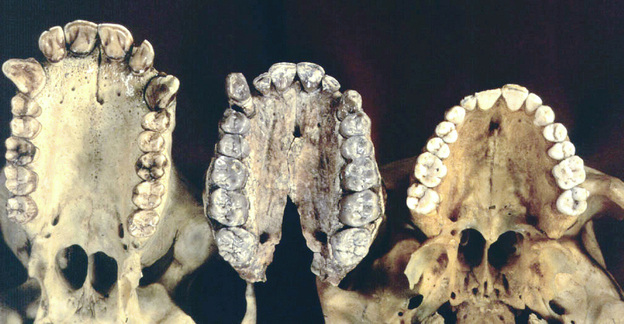The Influence of Fire
Upon Early Eating Habits & Anatomy
Britney Spindler
Prior to the advent of fire, humans ate a raw diet consisting of berries and nuts which could be easily scavenged, uncooked meats, and crunchy root vegetables. This type of diet provides very few calories; the crunchy roots, such as carrots and turnips, provide a large amount of caloric energy which was unavailable to humans previous to cooking. These foods are high in cellulose and starch, which the human stomach has difficulties extracting nutrients from. Humans also had difficulties digesting meat. These problems were solved by fire.
|
Beets, potatoes, and carrots are all modern examples of the starch-heavy, crunchy roots and tubers which early humans partook in.
Click for source. Roasted Root Vegetables. 2009. Photograph. This image shows the gradual progression of teeth from the early human's sharp tools with which to tear and pull, to much softer teeth of modern humans, used primarily to mash. Click for source.
Kimbel, William. "Om Nom Nom" N.d. Photograph. Institute of Human Origin, n.p. |
Works Cited
Joyce, Christopher. "Food For Thought: Meat-Based Diet Made Us Smarter." NPR. NPR, 02 Aug. 2010. Web. 01 Oct. 2012. <http://www.npr.org/2010/08/02/128849908/food-for-thought-meat-based-diet-made-us-smarter>.
Nicholson, Ward. "First Control of Fire by Human Beings--How Early?" Beyond Vegetarianism. N.p., n.d. Web. 04 Oct. 2012. <http://www.beyondveg.com/nicholson-w/hb/hb-interview2c.shtml>.
Viegas, Jennifer. "Homo Erectus Ate Crunchy Food." ABC Science. Discovery News, 22 Nov. 2005. Web. 01 Oct. 2012. <http://www.abc.net.au/science/articles/2005/11/22/1514032.htm>.
Nicholson, Ward. "First Control of Fire by Human Beings--How Early?" Beyond Vegetarianism. N.p., n.d. Web. 04 Oct. 2012. <http://www.beyondveg.com/nicholson-w/hb/hb-interview2c.shtml>.
Viegas, Jennifer. "Homo Erectus Ate Crunchy Food." ABC Science. Discovery News, 22 Nov. 2005. Web. 01 Oct. 2012. <http://www.abc.net.au/science/articles/2005/11/22/1514032.htm>.


